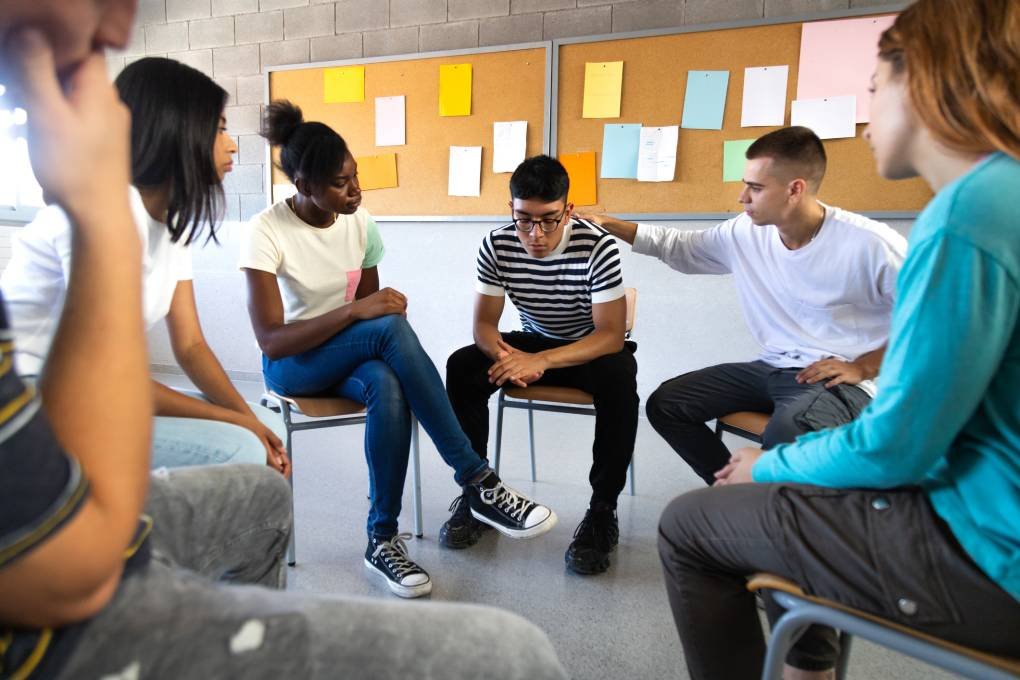Pre-teen boys showed the greatest struggle with conduct problems – such as cheating, fighting and stealing – and hyperactive and inattentive behaviors in the last six months of 2023. According to the study, 24% of pre-teen boys experienced mental health issues related to hyperactive and inattentive behaviors, while they also scored high on conduct issues, when compared to the other groups surveyed.
2. Teenage girls scored highest for emotional symptoms tied to poor mental health.
Teenage girls were found to have higher levels of negative mental health outcomes in many areas, but the highest were in emotional symptoms, which the study defined as “depressive behaviors, anxiety, nerves, fears and internalizing symptoms of those emotions,” such as stomach aches and headaches. Teen girls were also the most likely demographic to be struggling in multiple areas, according to the report.
3. The mental health services schools say they offer and what parents report being available don’t match.
According to Rapaport, there is also a discrepancy between what parents said was available in their children’s schools and what schools report nationally as being available. The study defined mental health supports as “counseling therapy guidance, counseling, case management support programs based on specific needs.”
“I suspect that there’s a lack of awareness of services in some of the districts [or] maybe the services are in the schools, but there’s a waiting list and the parent can’t get their child in,” Rapaport said.
4. The kids who need the most in-school mental health support have the least access to it.
Families with the lowest incomes reported the lowest numbers of in-school mental health supports, while families with the highest incomes reported the highest numbers. However, when asked, only 11% of families with the highest income said that their children used the mental health supports provided in school. Conversely, over 50% of families with the lowest incomes reported that their children used in-school mental health services. “It is unlikely that this pattern reflects a difference in need; it is more likely that highest-income families are seeking services outside school,” the report said.
Less than one third of Black families reported that their school had mental health supports for students, but more than one half of white families reported availability of mental health services in their schools. A deeper dive into barriers to mental health services at the local level is needed, Rapaport said. “What one district is struggling with might not be the same as what another district or school is struggling with.”
Mental health support services in school
Polikoff pointed to school-based mental health services as an important part of addressing youth mental health needs, especially for families with limited resources. Because young people spend most of their day in school, “it makes sense to have resources there, especially when parents have so many other stressors, things that they’re worried about and trying to do,” said Kelly Davis, the vice president of Peer and Youth Advocacy at Mental Health America (MHA), which provides programming to help young people advocate for their and their peers’ mental health. “We know mental health services are incredibly expensive,” said Davis, who looks at mental health services in school as an issue of equity.
Youth Mental Health Corps, a public-private collaboration between AmeriCorps and several other organizations, launched earlier this year with a plan to train 18- to 24-year-olds to provide mental health services to young people in areas with shortages of mental health professionals.
The OneStar Foundation, a non-profit that partners with AmeriCorps, has helped to bring 80 Youth Mental Health Corps members to schools throughout Texas, one of four states to adopt the program for the 2024-2025 school year. According to Jaclyn Kolar, OneStar’s director of national service, one of the goals is to prevent dropouts by addressing students’ mental health needs.The Youth Mental Health Corps in Texas offer weekly one-on-one and small group sessions to economically disadvantaged students. These in-school sessions help students learn coping strategies, build self-esteem and practice goal-setting, said Kolar.
Teens finding solutions
For Rishika Rohatgi, the report’s findings are familiar. During the COVID-19 pandemic, Rohatgi noticed the increased loneliness and isolation among her peers, on top of the academic, extracurricular and social pressures they were already experiencing as teenagers. So she and a friend started a mental health awareness club at their high school. After they participated in their school’s activity fair, 50 students joined. “We saw such a positive reaction almost immediately,” said Rohatgi, a former NAMI Next Gen Advisor. While no professional mental health services were offered through the club, it created a space for an open-ended dialogue between students. “Students really need advocacy that is for students and by students,” she said.
Rohatgi highlighted the importance of creativity when approaching students about mental health difficulties. For example, on Valentine’s Day, students in her club decided to write love letters to themselves “to highlight the traits of themselves that they loved.” Rohatgi’s club often found success with activities, like the love letters, that “boost mental wellness, but don’t explicitly say that they’re boosting mental wellness,” she said.








